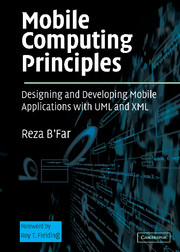Book contents
- Frontmatter
- Contents
- Foreword by Roy T. Fielding
- Acknowledgments
- SECTION 1 INTRODUCTIONS TO THE MAIN TOPICS
- Chapter 1 Introduction to Mobile Computing
- Chapter 2 Introduction to Mobile Development Frameworks and Tools
- Chapter 3 XML: The Document and Metadata Format for Mobile Computing
- Chapter 4 Introduction to UML
- SECTION 2 DEVICE-INDEPENDENT AND MULTICHANNEL USER INTERFACE DEVELOPMENT USING UML
- SECTION 3 ADDITIONAL DIMENSIONS OF MOBILE APPLICATION DEVELOPMENT
- SECTION 4 PUTTING THE PROJECT TOGETHER
- References
- Index
Chapter 1 - Introduction to Mobile Computing
from SECTION 1 - INTRODUCTIONS TO THE MAIN TOPICS
Published online by Cambridge University Press: 03 September 2009
- Frontmatter
- Contents
- Foreword by Roy T. Fielding
- Acknowledgments
- SECTION 1 INTRODUCTIONS TO THE MAIN TOPICS
- Chapter 1 Introduction to Mobile Computing
- Chapter 2 Introduction to Mobile Development Frameworks and Tools
- Chapter 3 XML: The Document and Metadata Format for Mobile Computing
- Chapter 4 Introduction to UML
- SECTION 2 DEVICE-INDEPENDENT AND MULTICHANNEL USER INTERFACE DEVELOPMENT USING UML
- SECTION 3 ADDITIONAL DIMENSIONS OF MOBILE APPLICATION DEVELOPMENT
- SECTION 4 PUTTING THE PROJECT TOGETHER
- References
- Index
Summary
Where is the life we have lost in living? Where is the knowledge we have lost in information? Where is the wisdom we have lost in knowledge?
T. S. ElliotINTRODUCTION
Mobile computing systems are computing systems that may be easily moved physically and whose computing capabilities may be used while they are being moved. Examples are laptops, personal digital assistants (PDAs), and mobile phones. By distinguishing mobile computing systems from other computing systems we can identify the distinctions in the tasks that they are designed to perform, the way that they are designed, and the way in which they are operated. There are many things that a mobile computing system can do that a stationary computing system cannot do; these added functionalities are the reason for separately characterizing mobile computing systems.
Among the distinguishing aspects of mobile computing systems are their prevalent wireless network connectivity, their small size, the mobile nature of their use, their power sources, and their functionalities that are particularly suited to the mobile user. Because of these features, mobile computing applications are inherently different than applications written for usage on stationary computing systems. And this brings me to the central motivation behind authoring this book.
The application development and software engineering disciplines are very young engineering disciplines compare to those such as structural, mechanical, and electrical engineering. Software design and implementation, for the most part, remains part art and part science.
Information
- Type
- Chapter
- Information
- Mobile Computing PrinciplesDesigning and Developing Mobile Applications with UML and XML, pp. 3 - 28Publisher: Cambridge University PressPrint publication year: 2004
